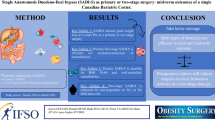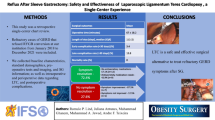Abstract
Background
Obesity and metabolic disorders related to it have become a serious problem in Asia. Furthermore, gastric cancer in Asia is one of the frequent diseases on which to perform treatments. We introduced the technique of laparoscopic sleeve gastrectomy with duodenojejunal bypass (LSG/DJB) for patients with a risk of gastric cancer and compared the results of our initial series with those of other procedures.
Methods
Twenty-one patients underwent a LSG/DJB from April 2007 to November 2008. The mean preoperative weight and body mass index (BMI) were 108.0 kg and 41.0 kg/m2, respectively. High risks of gastric cancer were determined as having a Helicobacter pylori positive with atrophic change of mucosa or a family history of gastric cancer. Operations were performed with five ports. Initially, SG and dissection of posterior wall of duodenum were carried out. Subsequently, DJB was added with 50–100 cm of biliopancreatic tract and 150–200 cm of alimentally tract. DJB consisted of a jejunojejunostomy created by a linear stapler and hand sewing closure and duodenojujunostomy by hand sewing with two layers.
Results
A LSG/DJB was performed successfully in all patients. The mean operation time was 217 ± 38 min. The weight loss and percent excess BMI loss for LSG/DJB were similar to those for laparoscopic Roux-en-Y gastric bypasses. There was no mortality; however, one patient had leakage from a staple line of esophagogastric junction and reqiured drainage and stenting. No dumping, stenosis, marginal ulcer, or nutritional problems were observed during postoperative follow-up. All of the main comorbidities improved after this procedure.
Conclusion
LSG/DJB is a feasible, safe, and effective procedure for the treatment of morbidly obese patients with the risk of gastric cancer.


Similar content being viewed by others
References
Kasama K, Tagaya N, Kanahira E, et al. Has laparoscopic bariatric surgery been accepted in Japan? The experience of a single surgeon. Obes Surg. 2008;18:1473–8.
Tagaya N, Kasama K, Inamine S, et al. Evaluation of the excluded stomach by double-balloon endoscopy after laparoscopic Roux-en-Y gastric bypass. Obes Surg. 2007;17:1165–70.
Himpens J, Dapri G, Cadière GB. A prospective randomized study between laparoscopic gastric banding and laparoscopic isolated sleeve gastrectomy: results after 1 and 3 years. Obes Surg. 2006;16:1450–6.
Moon Han S, Kim WW, Oh JH. Results of laparoscopic sleeve gastrectomy (LSG) at 1 year in morbidly obese Korean patients. Obes Surg. 2005;15:1469–75.
Langer FB, Reza Hoda MA, Bohdjalian A, et al. Sleeve gastrectomy and gastric banding: effects on plasma ghrelin levels. Obes Surg. 2005;15:1024–9.
Laferrère B, Heshka S, Wang K. Incretin levels and effect are markedly enhanced 1 month after Roux-en-Y gastric bypass surgery in obese patients with type 2 diabetes. Obes Surg. 2007;17:1709–16.
Rubino F, Forgione A, Cummings DE, et al. The mechanism of diabetes control after gastrointestinal bypass surgery reveals a role of the proximal small intestine in the pathophysiology of type 2 diabetes. Ann Surg. 2006;244:741–9.
Lee WJ, Wang W. Bariatric surgery: Asia-Pacific perspective. Obes Surg. 2005;15:751–7.
Uemura N, Okamoto S, Yamamoto S, et al. Helicobacter pylori infection and the development of gastric cancer. N Engl J Med. 2001;345:784–9.
Wong BC, Lam SK, Wong WM, et al. Helicobacter pylori eradication to prevent gastric cancer in a high-risk region of China: a randomized controlled trial. JAMA. 2004;291:187–94.
Smith BR, Schauer P, Nguyen NT. Surgical approaches to the treatment of obesity: bariatric surgery. Endocrinol Metab Clin N Am. 2008;37:943–64.
Tice JA, Karliner L, Waish J, et al. Gastric banding or bypass? A systematic review comparing the two most popular bariatric procedures. Am J Med. 2008;121:885–93.
Biertho L, Steffen R, Ricklin T, et al. Laparoscopic gastric bypass versus laparoscopic adjustable gastric banding: a comparative study of 12, 00 cases. J Am Coll Surg. 2003;197:536–47.
Jan JC, Hong D, Pereira N, et al. Laparoscopic adjustable gastric banding versus laparoscopic gastric bypass for morbid obesity: a single-institution comparison study of early results. J Gastrointest Surg. 2005;9:30–41.
Weber M, Muller MK, Boucher T, et al. Laparoscopic gastric bypass is superior to laparoscopic gastric banding for treatment of morbid obesity. Ann Surg. 2004;240:975–83.
Himpens J, Dapri G, Cadiere GB. A prospective randomized study between laparoscopic gastric banding and laparoscopic isolated sleeve gastrectomy: results after 1 and 3 years. Obes Surg. 2006;16:1450–6.
Baltasar A, Bou R, Miró J, et al. Laparoscopic biliopancreatic diversion with duodenal switch: technique and initial experience. Obes Surg. 2002;12:245–8.
Gagner M, Matteotti R. Laparoscopic biliopancreatic diversion with duodenal switch. Surg Clin North Am. 2005;85:141–9.
Del Genio G, Rossetti G, Brusciano L, et al. Laparoscopic duodenal switch for pathologic duodenogastric reflux: initial experience. Surg Laparosc Endosc Percutan Tech. 2007;17:517–20.
Del Genio G, Gagner M, Cuenca-Abente F, et al. Laparoscopic sleeve gastrectomy with duodeno-jejunal bypass: a new surgical procedure for weight control. Feasibility and safety study in a porcine model. Obes Surg. 2008;18:1263–7.
Gagner M, Boza C. Laparoscopic duodenal switch for morbid obesity. Expert Rev Med Devices. 2006;3:105–12.
Buchwald H, Avidor Y, Braunwald E, et al. Bariatric surgery: a systematic review and meta-analysis. JAMA. 2004;292:1724–37.
Baxter JN, Grime JS, Critchley M, et al. Relationship between gastric emptying of a solid meal and emptying of the gallbladder before and after vagotomy. Gut. 1987;28:855–63.
Stadaas JO. Intragastric pressure/volume relationship before and after proximal gastric vagotomy. Scand J Gastroenterol. 1975;10:129–34.
Cohen RV, Schiavon CA, Pinheiro JS, et al. Duodenal-jejunal bypass for the treatment of type 2 diabetes in patients with body mass index of 22–34 kg/m2: a report of 2 cases. Surg Obes Relat Dis. 2007;3:195–7.
Ramos AC, Galvão Neto MP, de Souza YM, et al. Laparoscopic duodenal-jejunal exclusion in the treatment of type 2 diabetes mellitus in patients with BMI<30 kg/m2 (LBMI). Obes Surg. 2009;19:307–12. Epub 2008 Nov 6.
Rosenthal R, Li X, Samuel S, et al. Effect of sleeve gastrectomy on patients with diabetes mellitus. Surg Obes Relat Dis. 2009. In press. doi:https://doi.org/10.1016/j.soard.2008.11.006
Baltasar A, del Rio J, Escrivá C, et al. Preliminary results of the duodenal switch. Obes Surg. 1997;7:500–4.
Bloomberg RD, Fleishman A, Nalle JE, et al. Nutritional deficiencies following bariatric surgery: what have we learned? Obes Surg. 2005;15:145–54.
Author information
Authors and Affiliations
Corresponding author
Rights and permissions
About this article
Cite this article
Kasama, K., Tagaya, N., Kanehira, E. et al. Laparoscopic Sleeve Gastrectomy with Duodenojejunal Bypass: Technique and Preliminary Results. OBES SURG 19, 1341–1345 (2009). https://doi.org/10.1007/s11695-009-9873-z
Received:
Accepted:
Published:
Issue Date:
DOI: https://doi.org/10.1007/s11695-009-9873-z




